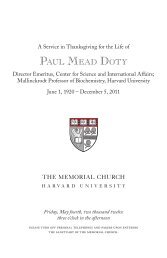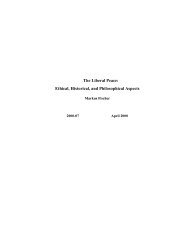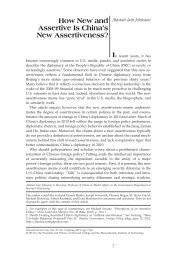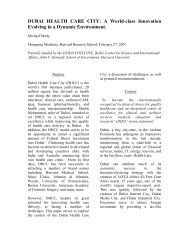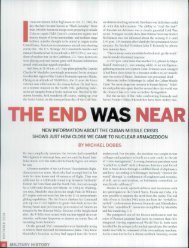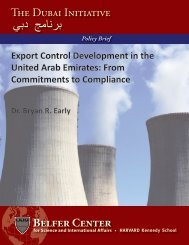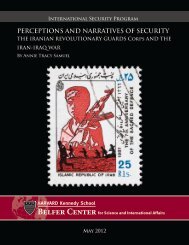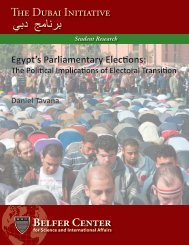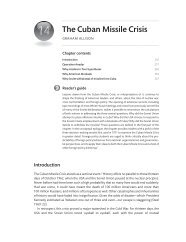Warlordism in Comparative Perspective - MIT Press Journals
Warlordism in Comparative Perspective - MIT Press Journals
Warlordism in Comparative Perspective - MIT Press Journals
You also want an ePaper? Increase the reach of your titles
YUMPU automatically turns print PDFs into web optimized ePapers that Google loves.
United States <strong>in</strong>itially supported some warlord factions <strong>in</strong> the hope that they<br />
would work together to overcome the anarchy that prevailed <strong>in</strong> the country <strong>in</strong><br />
the early 1990s. More recently, the United States reportedly gave military and<br />
economic assistance to warlords ªght<strong>in</strong>g the UIC, as part of the war on terrorism,<br />
because the UIC was thought to be harbor<strong>in</strong>g pro-al-Qaida elements. 12<br />
The United Nations also supported warlord-dom<strong>in</strong>ated political negotiations<br />
<strong>in</strong> Somalia and Afghanistan <strong>in</strong> the early 2000s that led to the creation of<br />
new national governments <strong>in</strong> both countries. 13 Warlords were given top m<strong>in</strong>isterial<br />
posts and other <strong>in</strong>ºuential positions (such as governorships and police<br />
chief roles) with the bless<strong>in</strong>g of the <strong>in</strong>ternational community, even though this<br />
allowed them to cont<strong>in</strong>ue with impunity activities that underm<strong>in</strong>ed the states’<br />
authority. Ironically, by support<strong>in</strong>g the warlords, both the United States and<br />
the broader <strong>in</strong>ternational community weakened the state <strong>in</strong>stitutions they<br />
were help<strong>in</strong>g to create.<br />
A Deªnition of <strong>Warlordism</strong><br />
International Security 31:3 46<br />
Several analysts have offered deªnitions of warlordism, 14 but none has been<br />
well del<strong>in</strong>eated or rigorous, and none has been adopted as standard usage.<br />
the exist<strong>in</strong>g literature<br />
William Reno’s groundbreak<strong>in</strong>g work on African warlordism has made him<br />
perhaps the most widely cited scholar <strong>in</strong> the warlordism genre. Reno does not,<br />
however, offer a clear deªnition of warlordism as a system to dist<strong>in</strong>guish it<br />
from other types of rule. In particular, he blurs the dist<strong>in</strong>ction between<br />
12. For an <strong>in</strong>side description of U.S. policy <strong>in</strong> the early 1990s, see John L. Hirsch and Robert B.<br />
Oakley, Somalia and Operation Restore Hope: Reºections on Peacemak<strong>in</strong>g and Peacekeep<strong>in</strong>g (Wash<strong>in</strong>gton,<br />
D.C.: United States Institute of Peace <strong>Press</strong>, 1995). For reports of more recent U.S. support for Somali<br />
warlords, see International Crisis Group, “Counter-terrorism <strong>in</strong> Somalia: Los<strong>in</strong>g Hearts and<br />
M<strong>in</strong>ds?” Africa Report, No. 95 (Brussels: International Crisis Group, July 11, 2005); and Craig<br />
Timberg, “Mistaken Entry <strong>in</strong>to Clan Dispute Led to U.S. Black Eye <strong>in</strong> Somalia,” Wash<strong>in</strong>gton Post,<br />
July 2, 2006.<br />
13. For critiques of this process <strong>in</strong> Afghanistan, see Laura Secor, “The Pragmatist,” Atlantic<br />
Monthly, Vol. 294, No. 1 (July/August 2004), p. 44; Kathy Gannon, “Afghanistan Unbound,” Foreign<br />
Affairs, Vol. 83, No. 3 (May/June 2004), pp. 35–46; and Suhrke, Harpviken, and Strand,<br />
Conºictual Peacebuild<strong>in</strong>g.<br />
14. Prom<strong>in</strong>ent examples <strong>in</strong>clude Sasha Lezhnev, Craft<strong>in</strong>g Peace: Strategies to Deal with Warlords <strong>in</strong><br />
Collaps<strong>in</strong>g States (Lanham, Md.: Lex<strong>in</strong>gton, 2005); Paul Jackson, “Warlords as Alternative Forms of<br />
Governance,” Small Wars and Insurgencies, Vol. 14, No. 2 (Summer 2003), pp. 131–150; Gordon<br />
Peake, “From Warlords to Peacelords?” Journal of International Affairs, Vol. 56, No. 2 (Spr<strong>in</strong>g 2003),<br />
pp. 181–191; William Reno, Warlord Politics and African States (Boulder, Colo.: Lynne Rienner, 1998);<br />
and William Reno, “Maªya Troubles, Warlord Crises,” <strong>in</strong> Mark R. Beiss<strong>in</strong>ger and Crawford Young,<br />
eds., Beyond State Crisis? Postcolonial Africa and Post-Soviet Eurasia <strong>in</strong> <strong>Comparative</strong> <strong>Perspective</strong> (Baltimore,<br />
Md.: Johns Hopk<strong>in</strong>s University <strong>Press</strong>, 2002).



